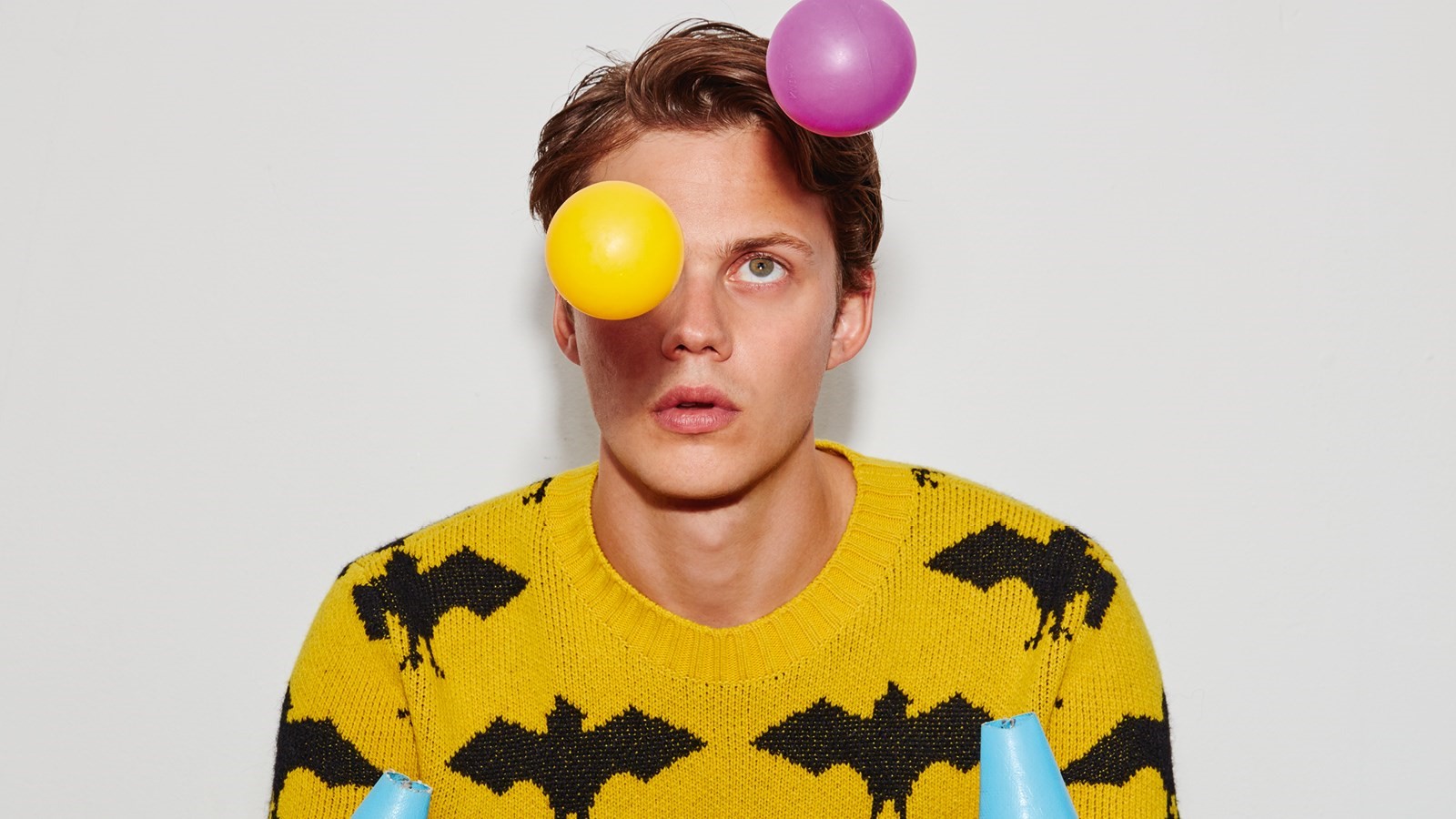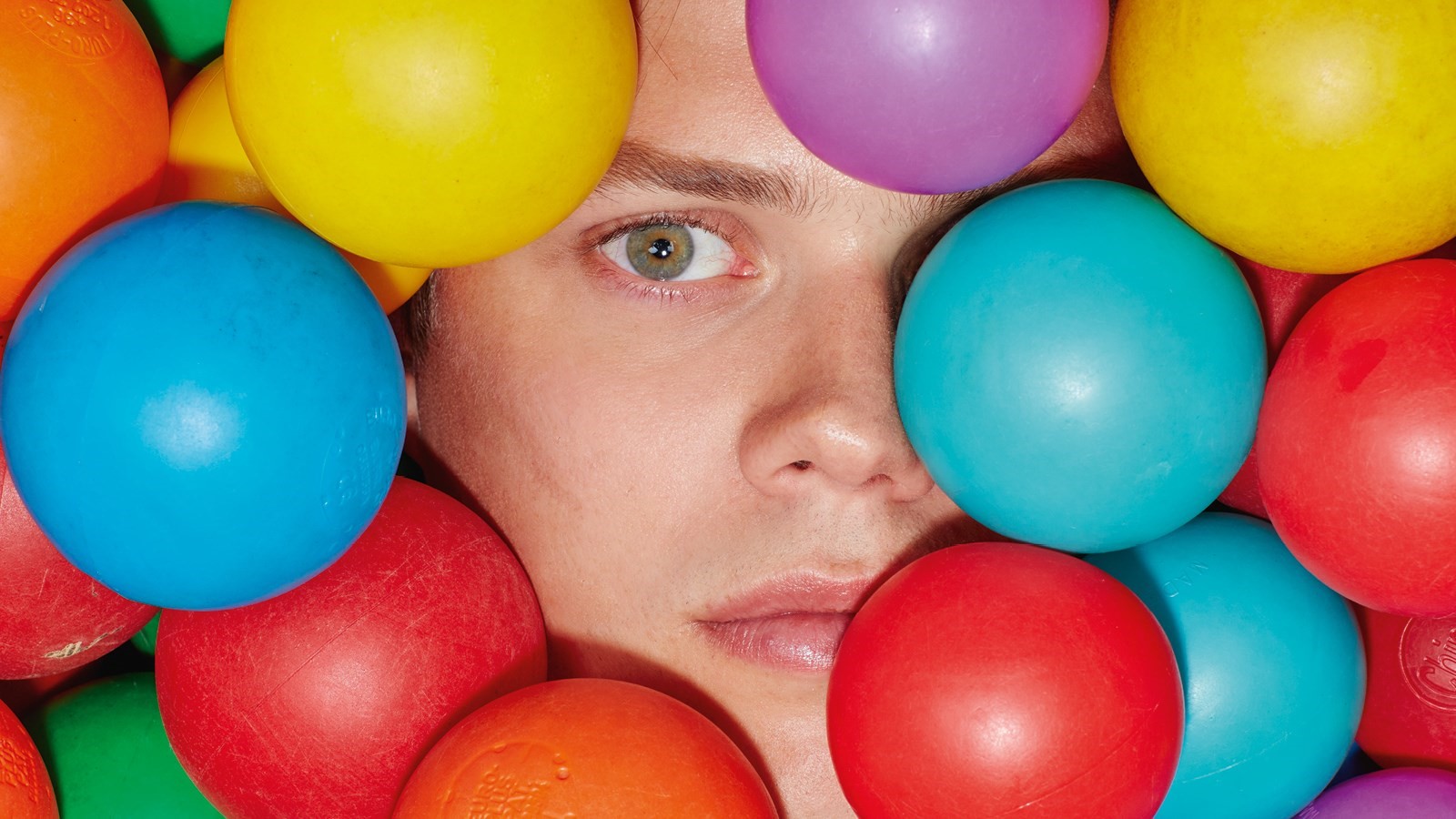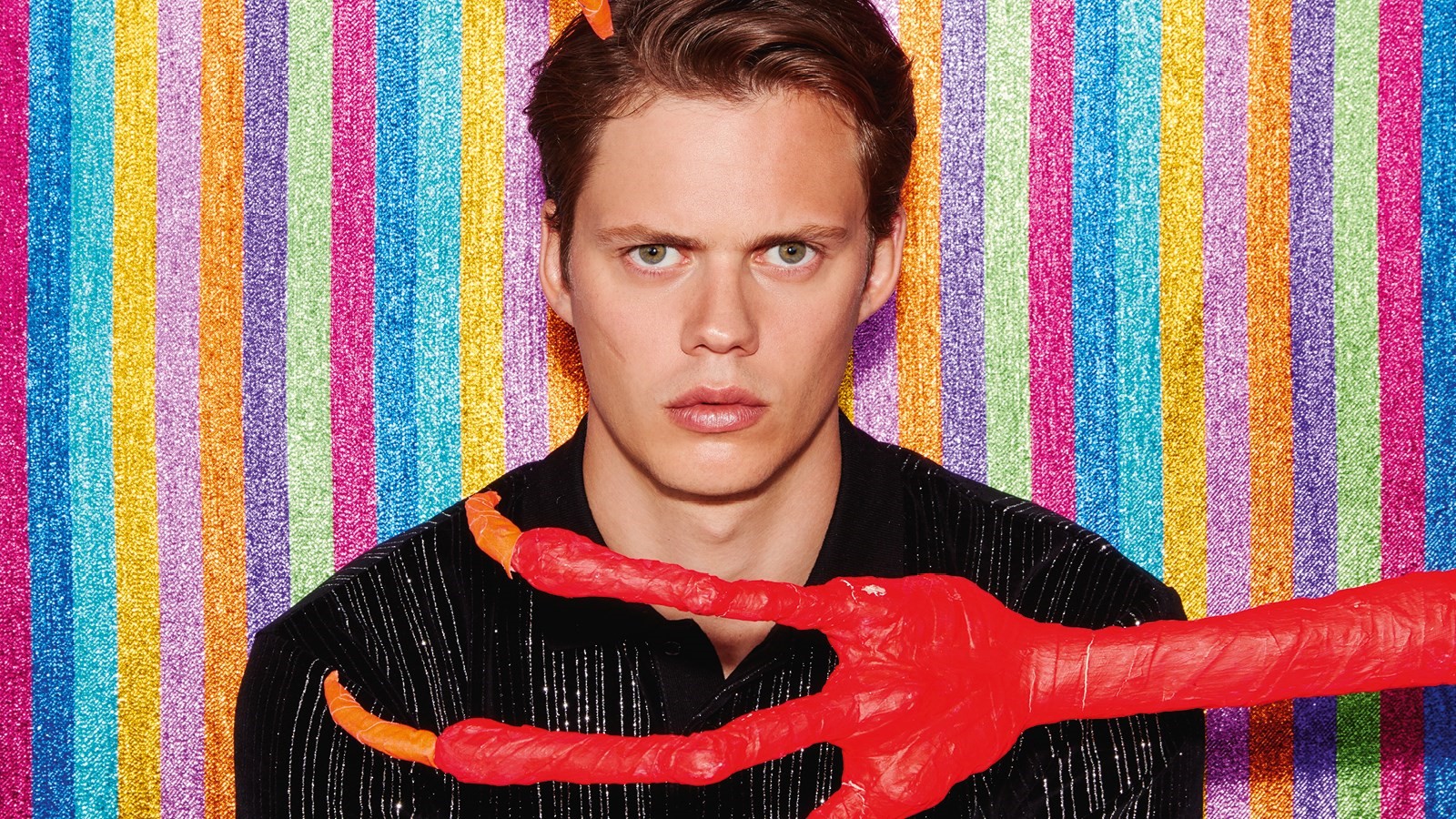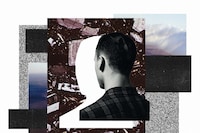Set to terrify a whole new generation of film-goers as Pennywise the clown, Bill Skarsgård discusses taking on Stephen King’s most iconic creation
Taken from the autumn issue of Dazed. You can buy a copy of our latest issue here.
Bill Skarsgård is sitting on a couch in an east London studio, talking in full flow when, out of the corner of my eye, I catch someone walking past with a red balloon. Distraction ensues for a split-second – not that the actor notices. Once you’ve experienced Skarsgård’s performance as shapeshifting clown Pennywise in It, where his every conjuring is marked by a wandering red balloon, you will understand how something so seemingly banal becomes major. From now on, red balloons can only mean ‘get the hell out of here’. All red balloons must. Be. Destroyed.
You’ll know the story of It, if only from legend. Pennywise appears in the town of Derry, Maine every 27 years, feeding on local children by exploiting their darkest fears. The year is 1989, and it’s up to a group of young outsiders dubbed the Losers’ Club to stop more kids disappearing (or having their arm chopped off while chatting into a stormdrain).
There is a lot of fond affection for the 1990 mini-series adaptation of Stephen King’s 1,100-page novel, published in 1986. As such, it’s a brave decision to put another spin on it. But the tale, now considered a modern classic, has plenty to draw upon for a reimagining. And everyone’s waiting with bated breath: the trailer for this new movie, directed by Andrés Muschietti, racked up an incredible 197 million views online in one day alone, setting a new record for the most views in a 24-hour period. Whatever happens, it’s already a hit.
“What was so iconic about not only the novel but also the mini-series was that kids saw it at too early an age,” Skarsgård offers. “If you saw the mini-series when you were an adolescent it wouldn’t have affected you as much, but if you were the same age as the kids who are the victims in the movie, that was when it was most effective. I had people coming up to me all the time being like, ‘Oh my God, I can’t believe you’re doing It! That movie just traumatised me, I was so scared.’ It’s kind of a fascination-slash-fear-slash-whatever it was that they lived through. It’s the strangest thing, ’cos obviously kids aren’t supposed to see this film, but there are kids in it.”
In throwing out the goofy camp of Tim Curry’s turn as Pennywise for a truly unsettling, Vantablack-like take on the character as partchild, part-monster, Skarsgård has achieved what every actor sets out to do: leave a mark on his audience long after the end credits roll and the flip-down seats empty. He is set to be the default totem of fear for a new generation of nearly-teens, while It is anointed the new benchmark watch-once-and-never-again movie. (‘Never again’ here being a badge of honour – the film only requires one sitting to sear itself on to your brain, whether you want it there or not.) Just ask the extras from a scene in the film in which Pennywise appears on TV to terrorise a group of kids, all children younger than the main cast.

“I walked into this scene, in character, where these kids were sitting,” says Skarsgård. “They’d never even met me before, let alone seen me as Pennywise. Andy (Muschietti) is behind the camera shouting directions and he’s like, ‘Bill, grab one of the kids! Grab one of the kids and walk out of the frame!’ So I’m running around these kids, laughing maniacally, and I grab one and he just shrieks! And Andy’s like, ‘Oh no, not that guy!’ – I had to change kids to find one that wasn’t so terrified. It was weird because as soon as they said ‘cut’, some kids were very shaken up about it. I tried to be like, ‘Oh, I’m just an actor, this is just pretend,’ and they kind of looked at me very suspiciously. It just hit me that it’s this strange thing: if I do my job right, and I’m as terrifying as I want the character to be, there are gonna be a lot of people that have this kind of reaction to the performance and the film. It’s a strange thing to have to deal with.”
Preserving the purity of unfamiliarity, even the Losers’ Club met him just once before filming, at the read-through. The first time they saw Bill in full clown make-up was on set.
“There’s a scene with Jack (Dylan Grazer), who plays (Losers’ Club member) Eddie,” says Skarsgård. “I come out of this refrigerator and start walking towards him, very much in his face. When they shout action, I get really into it – it’s really, really intense. I’m drooling all over him, and Jack is, like, gagging and crying and screaming and it’s horrible, but you know, it’s for the movie. I kind of plough through and then as soon as they say ‘cut’ I go, ‘Hey, yo, are you OK Jack?’ And he turns to me and goes, ‘Yeah man, that’s fucking awesome! I love what you’re doing, you’re awesome!’ He’s turned on a dime and I’m like, ‘What are you?’ They’re like little professionals.”
“There’s this line in the novel where (one of the Losers) Mike Hanlon is analysing what he thinks Pennywise might be, and he comes to the conclusion that he’s the entity’s favourite form. So there’s this sense of enjoyment that this entity has while he is a clown – he’s getting off on it” – Bill Skarsgård
Filming in Toronto over three months last year, Skarsgård put the work into creating his version of Pennywise. The movie was well over a month into production before he shot his first scene, time he put to good use figuring out what to do with the character.
“I did have a lot of time by myself,” he says. “And sleepless nights on all the different ways I could probably do it wrong. I’ve done adaptations before, but never something where there’s been this much anticipation. I had to tell myself, ‘I’m putting a lot of thought and care into this character and this performance’ – at the end of the day, as long as I feel that I’m proud of the outcome, that’ll ultimately have to be good enough. At this point, I’m excited to see how people respond.”
Skarsgård was eager to explore the twisted and tormented entity behind the clown itself – pretty much as abstract a character as you can get. “Pennywise is a form that this entity is using – a manifestation of children’s fears,” he explains. “I wanted to figure out not only who the clown is, but also what’s behind the clown. Part of that was making it a lot more psychological and kind of glitchy and strange and unpredictable. There’s this line in the novel where (one of the Losers) Mike Hanlon is analysing what he thinks Pennywise might be, and he comes to the conclusion that he’s the entity’s favourite form. So there’s this sense of enjoyment that this entity has while he is a clown – he’s getting off on it. I thought those things were really interesting to explore, to create something that is very unsettling in terms of its unpredictability. I worked really hard trying to get that to the screen... There’s so much more to the thing than what’s being said.”

Physically, there are attributes to the performance that are very much Skarsgård, albeit pushed to startling extremes. The actor is just about recognisable through the layers of make-up, though his matinee-idol looks have been turned to searing distortion.
“I have a bit of a lazy eye on my left side, so if I relax the muscle in the eye, my left eye goes out and I become completely wall-eyed,” he says. “We thought that would be cool to use in the character, so throughout the film his eyes are pointing in two different directions. There’s the lisp as well. Those are things I was playing around with even before I tried the make-up on. I had prosthetic pieces on my cheeks – when you have those puffy cheeks it really makes you come off as much more childlike in appearance. That was something we wanted to explore. He is the manifestation of children, so he’s sort of part-child himself. He has these childlike elements – which is a different take on it, obviously, and something that I find pretty disturbing.”
The film’s young actors – led by Jaeden Lieberher, Sophia Lillis, and Stranger Things’ Finn Wolfhard – enjoyed themselves as much as its malevolent lead, with profanity raging throughout. “They’re not allowed to swear in front of their parents, but as soon as the camera was rolling they were allowed to say whatever they wanted,” says Skarsgård. “That’s realism – I’ve never cursed more than when I was 12 or 13, because that’s around the age where you’re trying to explore and it’s exciting to say all these things to your friends. (When) I saw the film I was like, ‘I don’t know if we’re breaking some sort of record here.’ You know how Scarface had, like, 276 ‘fucks’ or whatever, and it’s in the Guinness Book of World Records? I don’t know if there’s any movie where 12-year-olds say ‘fuck’ as much as It.”

Perhaps the most eventful story regarding It is the bizarre real-life situation Skarsgård found himself in during shooting – this was the time of the 2016 clown attacks that swept like a virus across the planet, from North America to Europe, Australia and Latin America. Even the actor’s home country of Sweden was affected.
“It was kind of crazy,” he says. “We put out photos of what Pennywise looked like around the same time it started happening. My friends and family would send me articles like, ‘Hey Bill, what are you doing in Ohio?’ or, ‘Hey Bill, what are you doing in South Carolina?’ Obviously, there’s a difference between pretending to do it on film and doing it in real life.”
The media gave the attacks the sensational oxygen that they needed, creating a twisted intercontinental flashmob. But there’s a weighty psychology paper waiting to be written on why we see clowns as scary (one I’m not qualified to write). One thing is for sure: when considering clowns, it’s impossible to take Stephen King’s most famous creation out of the equation. Pennywise is too rooted in culture as a folk-bogeyman, part of our collective consciousness. Not unlike Father Christmas, who we think has been around forever – we forget he was given a red suit by Coca-Cola to sell pop.
“I don’t mind villainous parts – I think there’s something to them that makes them more complex and interesting, at least in the sense of ‘good guy, bad guy’. The good guys are usually pretty one-dimensional, where traditionally bad guys are more cunning” – Bill Skarsgård
For all the rumble, It, you’ll be glad to hear, is not all heavy. Even in the pitch-black, there is light. Peel back the layers of horror, and there’s a charming story about the irreplaceable freedom of summer, and coming out of the other side of the school holidays more experienced and more sure of yourself. There’s the power of friendship and bravery. Plus references to Molly Ringwald, a Psychedelic Furs poster on a bedroom wall, and a running joke about New Kids on the Block. Fans of the original can enjoy the new version with a knowing wink to their youth.
Spending time with Skarsgård, you forget that he is part of an elegant acting dynasty. He’ll mention it, but only if you ask. His dad is the celebrated Stellan Skarsgård – a figure long since praised as the actor’s actor. The family used to travel to wherever Stellan was filming, setting up base for a couple of months in Cambodia or Scotland. It’s perhaps why Bill doesn’t have a place of his own yet, preferring to rent wherever he is, hopping between LA, New York, Toronto and Sweden. The only mandatory requirement is space for entertaining – growing up at a big dinner table, with a lot of creative people around, is something Skarsgård is keen to carry on.
A powerhouse the Skarsgårds may be, but there’s nothing ‘Sylvia Young’ about their story (they’re too cool). Bill has four brothers, a sister and two half-brothers. Barring Sam, a doctor, and Eija, a model-turned-nightclub manager, the siblings all act – because, growing up and seeing what fun your dad has, why wouldn’t you? Alexander Skarsgård is the most Hollywood of the clan, 14 years senior to 26-year-old Bill. Such is the siblings’ range, none of them are fighting over roles.

It is Bill’s most high-profile role to date, and will see him become properly famous – he’s standing on the precipice, ready for the next phase of his career. He quickly outgrew the Swedish film industry after winning four starring roles in succession, including the acclaimed (and clumsily titled in translation) Simple Simon, playing a teenager with Asperger syndrome. Skarsgård already has a cult fanbase off the back of Hemlock Grove, a horror-tinged Netflix series of werewolves and vampires in which Skarsgård plays Roman, a rich kid masking his insecurities with sex, drugs and speeding around in a Jaguar XK150. (Sample scene: Roman slicing his finger with a razor and rubbing a blood Ouroboros on the shoulder of a prostitute.) Next year, he’ll return to the Stephen King universe in Hulu’s Castle Rock, a dark new series set in the author’s mythical Maine community.
“I wasn’t a huge fan of horror films growing up, I was never super into the sensation of getting scared,” he says, a surprising admission given his flair for dark roles. “But then I watched a lot because I’ve been doing horror so much.” His favourite? Cult South Korean bloodbath Oldboy. “The same DP, Chung-hoon Chung, also shot It,” he says, proudly.
“I don’t mind villainous parts – I think there’s something to them that makes them more complex and interesting, at least in the sense of ‘good guy, bad guy’. The good guys are usually pretty one-dimensional, where traditionally bad guys are more cunning. They have a lot more drive and motives and manipulation,” he notes.
“Dad and Lars (Von Trier’s) relationship is always something I’ve aspired to have – I do hope that I’ll find my own Lars in terms of someone I can make seven movies with” – Bill Skarsgård
“It’s a really hard thing to pinpoint what it is exactly that inspires you or that really makes you excited in terms of performance or characters,” he continues. “It’s kind of like defining what song will get you really going, you know? I just like to explore people that are different from me in every kind of way. Obviously, I wanna do as many different types of roles and characters as I can. I don’t think I’m there yet.”
A month or so before It hits the screen, you can catch Bill in Atomic Blonde, a cold-war spy film starring Charlize Theron and James McAvoy. Skarsgård plays Merkel, an east Berlin fixer in punk clothes and eyeliner. And he’s just wrapped Assassination Nation, starring Bella Thorne, Hari Nef, and R&B star Abra, slated for release this year. “Sam (Levinson) wrote this incredible script and as we were shooting it was taken to another level,” Skarsgård teases. “I’m so excited to see what he’s gonna do with it. It’s very about our time and what it means to be a young woman in today’s world.”
Skarsgård would, understandably, be happy if a call came from cinema’s most notorious auteur, Lars von Trier, who enjoys a long-running collaboration with dad Stellan, and cherry-picked Alexander for a role in 2011’s Melancholia.
“I think Lars is one of the better directors of our time; it’s always this combination of very dark, philosophical, hilarious movies,” he says. “There’s a particular voice of his that’s so unique to him, you can tell just by watching five minutes of any of his films. I’ve heard many stories about what it’s like to be on his sets – it’s extremely free, you’re encouraged to do every take as differently as you can, you just explore everything. Dad and Lars’ relationship is always something I’ve aspired to have – I do hope that I’ll find my own Lars in terms of someone I can make seven movies with.”

The only thing that rivals Skarsgård’s passion for acting, in the conversational stakes, is mixed martial arts – something he gets really animated about.
“I’m really addicted,” he says. “Alexander Gustafsson is this Swedish heavyweight fighter, he’s huge and obviously my go-to guy. He had this legendary fight with Jon Jones for the heavyweight belt in 2013 when we were shooting Hemlock Grove in Toronto. To date, it’s one of the best title fights in the history of (the sport).
The entire crowd had switched from Jones to this underdog Swede. Everyone was cheering him and it was a wonderful, surreal moment. He lost the fight, but he won the crowd.”
It’s almost – almost – like Skarsgård is telling a version of his own story. Everyone is willing him on – not least It director Andrés Muschietti. Even Stephen King tweeted back in March that the movie “succeeds beyond my expectations. Relax. Wait. And enjoy.”
“Bill brought an unsettling balance to Pennywise,” says Muschietti. “Ultra-magnetic and ambiguous, fluctuating between the child and the demon, the genius and the lunatic, the clown and the monster, the entertainer and the predator. He brought madness and unpredictability and layered the character deeply. He owned the role with no fear or hesitations – and blew everyone’s mind. I’ve never seen something like it.”
Whatever roles Skarsgård takes on in the future, spreading his wings and flexing his range, he’ll forever have status as a fright icon in the vault: Bill will always be It.
It is out September 8
Hair Chi Wong at Management + Artists using Bumble and bumble., make-up Thom Walker at Art + Commerce using Chanel Travel Diary, set design Gary Card at Streeters, photography assistant Torvioll Jashari, styling assistant Louise Ford, make-up assistant Luka Watanabe, set design assistants Andy Flett, Daniel Taylor, digital operator Rhys Thorpe, production Sylvia Farago, executive talent consultant Greg Krelenstein







